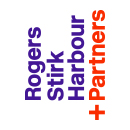Royal Academy architecture prize 2017
On 4 July 2017, the team behind Rogers Stirk Harbour + Partners (RSHP)'s Geneva Airport extension were awarded the prestigious Royal Academy Turkishceramics Prize for Architecture.
The £10,000 prize for an outstanding work of architecture, which they shared with a team from Herzog & de Meuron, was awarded in a ceremony at the Royal Academy in London.
2017’s architecture room at the summer show was curated by Farshid Moussavi, and focused on construction co-ordination drawings. Bahadir Kayan, one of the judges, said: “Moussavi’s call for construction co-ordination drawings brought together an outstanding show that unveils the unseen beyond models and images. Congratulations to RSHP and Herzog & de Meuron, who go to share the prize this year, for their outstanding submissions.”
Speaking after the team received the award, Douglas Paul, an architect at the practice, said:
“On large infrastructure projects it often takes many, many years to take the project from concept to completion. In the case of Geneva Airport’s Aile Est it will take at least ten years. Much of this time is spent by the architect trying to lead a vast range of consultants, the client body, experts, contractors, suppliers towards a common goal. It is not always glamorous work.
"The RA exhibition takes a refreshing and relatively rare interest in the process that leads to the executed work; the construction drawings. Gate 1 of 7 expresses the interest of RSHP – and Graham Stirk in particular – in the coordination and expression of structure and services which will ostensibly be exposed in the finished building. The static superstructure with its network of services contrasts with the dynamic arms of the telescopic air-bridges whose position varies depending on the size and model of the aircraft arriving at the stand.”
When completed, the Aile Est (east wing) project will represent an important improvement for Geneva Airport in terms of the flexibility of its operation and passenger comfort. It will facilitate an increase in medium-haul and long-haul flights, and strengthen Ganeva's position as a major European airport.
It will replace an existing temporary building with a "processor" with passport control booths for immigration and emigration, and Schengen and non-Schengen arrival and departure gates with airline lounges at mezzanine level.
The project is a collaboration between consultants based in four countries, which means good communication, including good technical and visual communication, is especially important. The building will be energy positive when built, with innovative sustainability features including:
- 110 geothermal piles for heating and cooling.
- Glazed facades guaranteeing a low dependency on artificial lighting.
- A high-performance solar protection strategy for the glazed facades.
- Approximately 4 000 m² of photovoltaic panels on the roof.
- An LED lighting strategy with responsive control systems.
- Low water consumption using methods such as rainwater harvesting.
--RSHP
[edit] Related articles on Designing Buildings Wiki
Featured articles and news
ECA Blueprint for Electrification
The 'mosaic of interconnected challenges' and how to deliver the UK’s Transition to Clean Power.
Grenfell Tower Principal Contractor Award notice
Tower repair and maintenance contractor announced as demolition contractor.
Passivhaus social homes benefit from heat pump service
Sixteen new homes designed and built to achieve Passivhaus constructed in Dumfries & Galloway.
CABE Publishes Results of 2025 Building Control Survey
Concern over lack of understanding of how roles have changed since the introduction of the BSA 2022.
British Architectural Sculpture 1851-1951
A rich heritage of decorative and figurative sculpture. Book review.
A programme to tackle the lack of diversity.
Independent Building Control review panel
Five members of the newly established, Grenfell Tower Inquiry recommended, panel appointed.
Welsh Recharging Electrical Skills Charter progresses
ECA progressing on the ‘asks’ of the Recharging Electrical Skills Charter at the Senedd in Wales.
A brief history from 1890s to 2020s.
CIOB and CORBON combine forces
To elevate professional standards in Nigeria’s construction industry.
Amendment to the GB Energy Bill welcomed by ECA
Move prevents nationally-owned energy company from investing in solar panels produced by modern slavery.
Gregor Harvie argues that AI is state-sanctioned theft of IP.
Heat pumps, vehicle chargers and heating appliances must be sold with smart functionality.
Experimental AI housing target help for councils
Experimental AI could help councils meet housing targets by digitising records.
New-style degrees set for reformed ARB accreditation
Following the ARB Tomorrow's Architects competency outcomes for Architects.
BSRIA Occupant Wellbeing survey BOW
Occupant satisfaction and wellbeing tool inc. physical environment, indoor facilities, functionality and accessibility.

























